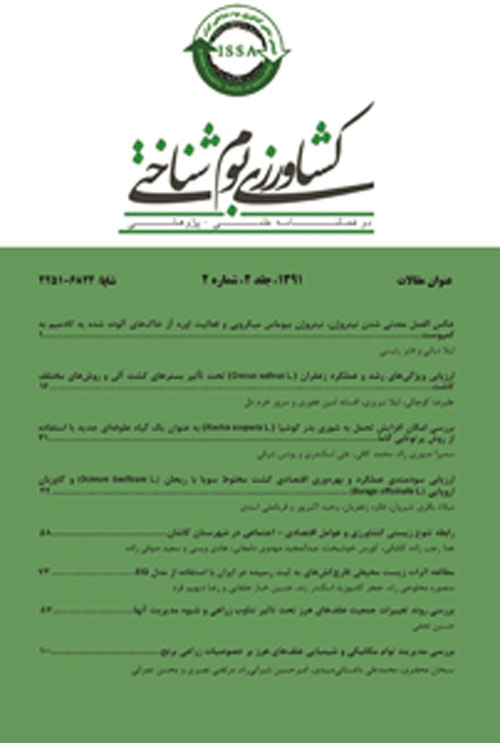Investigation the effect of intercropping of Persian clover cultivars on quantitative and qultitative of forage yield
Author(s):
Abstract:
Introduction
Intercropping is an example of a sustainable system in agriculture that has such purposes as creating ecological balance, higher utilization of resources, increase in the quantity and quality of the product and reducing pests, diseases and weeds (Koochaki and Zand, 1996). Persian clover (Trifolium resupinatum L.) is a plant native to Asia and Iran and contains both early (single cut) and late (multiple cut) ecotypes (Taylor, 1985). One new method in intercropping, namely the interspecies intercropping of different cultivars of Persian clover that causes an increase in the yield. However, little known about this method in the litreture (Prasad et al, 1990). The objective of this study was to investigate the effect of intercropping of early (single cut) and late (multiple cut) ecotypes Persian clover cultivars on quantitative and qualitative forage yield and determe the best seed rate and seed mix in the Karaj regionMaterials And Methods
In order to evaluate the effect of interspecies intercropping with Persian clover cultivars on increased forage yield, an experiment was carried out at the Seed and Planting Improvement Institute as a factorial design (base on a randomized completely block design (RCBD) with two factors (mixed seed at 5 levels, including 0-100,100-0,50-50,40-60,and 60-40 and seed rate at 3 levels of 10,15 and 20 kg ha-1) over two years (2012-13).Results And Discussion
The results of combined analysis of variance showed that the effect of year, seed rate and seed mix rate on the forage and dry matter yield and protein percentage, and the interaction of seed mixed × seed rate for just the protein percentage, were significant at 1% probability levels. Mean comparison of seed mixed × seed rate showed the highest forage and dry matter yield with 68.19 and 12.02 t ha-1 were obtained, respectively, from the treatment of 60% Persian clover (single harvest) and 40% multiple harvest Persian clover and seed rate 15 k ha-1. Also, the lowest forage and dry matter yields of 42.52 and 5.18 t ha-1 were obtained from the treatment of 100% multiple harvest Persian clover and the seed rate of 10 kg ha-1, respectively. The quality results showed that the highest crude protein at 24.77% was obtained from the treatment of 100% multiple cut harvest Persian clover and a seed rate of 10 kg ha-1. Evaluation of the land equivalent rate (LER) showed the highest evaluation efficiency at LER=2.85 was obtained from the treatment of 60% Persian clover (single cut) and 40% multiple cut harvest of Persian clover and a seed rate 10 kg ha-1, and for crude protein from the treatment of 40% Persian clover (single cut) and 60% multiple cut harvest Persian clover and a seed rate of 15 kg/ha with LER= 2.17, respectively.Conclusion
The results of this study indicate that interspecies mixed cropping of early and lately cultivars of Persian clover resulted in inceased forage yield compared to pure cropping. Since early cultivars have high a growth rate and suitable water and soil resources for utilization and high biomass production, in intercropping with late cultivars resulted in increased forage production in time and place units. The highest forage of 68.19 and LER=2.68 for forage yield, 12.02 t ha-1 and LER=2.85 for dry matter yield were obtained from the treatment of 60% Persian clover single cut and 40% multiple cut Persian clover and a seed rate of15 k ha-1. This mixed cropping model could be an agro-ecological approach for high forage production in crop systems. Keywords:
Language:
Persian
Published:
Journal of Agroecology, Volume:6 Issue: 2, 2017
Page:
278
magiran.com/p1680994
دانلود و مطالعه متن این مقاله با یکی از روشهای زیر امکان پذیر است:
اشتراک شخصی
با عضویت و پرداخت آنلاین حق اشتراک یکساله به مبلغ 1,390,000ريال میتوانید 70 عنوان مطلب دانلود کنید!
اشتراک سازمانی
به کتابخانه دانشگاه یا محل کار خود پیشنهاد کنید تا اشتراک سازمانی این پایگاه را برای دسترسی نامحدود همه کاربران به متن مطالب تهیه نمایند!
توجه!
- حق عضویت دریافتی صرف حمایت از نشریات عضو و نگهداری، تکمیل و توسعه مگیران میشود.
- پرداخت حق اشتراک و دانلود مقالات اجازه بازنشر آن در سایر رسانههای چاپی و دیجیتال را به کاربر نمیدهد.
In order to view content subscription is required
Personal subscription
Subscribe magiran.com for 70 € euros via PayPal and download 70 articles during a year.
Organization subscription
Please contact us to subscribe your university or library for unlimited access!



